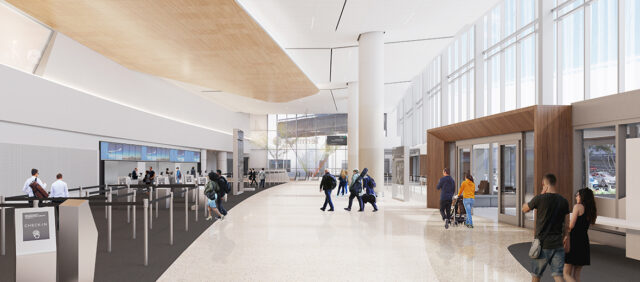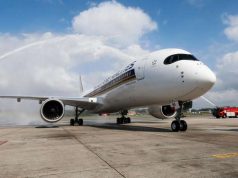
San Francisco International Airport’s Terminal 2 is, like many other airport terminals built in recent years, an aesthetic wonder. High ceilings, vast open spaces, ample natural lighting, and artwork combine to create a welcoming environment for travelers — a far cry from the gloomy passenger terminals of old.
But what really sets this terminal, reopening to passengers Thursday after a $383 million renovation project, apart from others is the attention to details — like power outlets and taps to fill water bottles — that the modern traveler will appreciate.
Departures lobby short on checkin counters, long on space
The experience begins as you walk through the doors into the lobby of the departures level — a vast, high-ceilinged area flooded with natural light and decorated with a sculpture by artist Kendall Buster.
But unlike other modern terminals from London to Shanghai — including SFO’s own International Terminal, which replaced Terminal 2 as the home to international flights when it opened in 2000 — the central space is not dominated by checkin counters. Indeed, apart from flight information boards and the escalator down from the AirTrain people mover system, there is nothing at all between the doors and the entrance to the security checkpoint.
All this means that, if you have checked in online and don’t have bags to check, you can walk straight from the curb or AirTrain to the security checkpoint with a minimum of fuss — evidence that the design, by the architectural firm Gensler, has been conceived with the needs of the modern business traveler in mind.
The two surprisingly small checkin counter areas, meanwhile, are tucked away on the sides, some distance away from the center of the lobby. Anchor tenant Virgin America, previously housed in the International Terminal, has its checkin area on the right, while American Airlines has its checkin positions on the left.
The reason for the relatively small number of checkin counters, however, is immediately apparent — both Virgin America and American have installed rows upon rows of automated self-checkin machines right in front of the counters. Clearly, the airlines expect their passengers to check in using the machines, saving everyone time — and reducing the airlines’ labor costs.
Two small, well-lit lounge areas provide seating, and a Starbucks Coffee is the only concession available pre-security.
10-lane security checkpoint should keep passengers moving
Unlike many older terminals, which strain to accommodate the demands of the post-9/11 security checkpoint, Terminal 2′s security checkpoint should be well up to the task of clearing passengers with a minimum of crowding and delay.
Like the entrances to the security checkpoints at SFO’s International Terminal, the checkpoint at Terminal 2 is separated from the departures lobby by a glass partition with sliding doors. Inside, ten security lanes should keep lines short and passengers moving even at the busiest of times.
Immediately past the security checkpoint is a broad, open “recompose” area where passengers can wait for companions, put on their shoes, and stow away their bags of liquids — a nice touch in an age of increasingly intrusive security procedures. An animated sculpture by Janet Echelman hangs from the ceiling, providing a touch of visual interest.
Mall-like environment for passengers to shop, eat
Past the recompose area, the terminal narrows, funneling passengers into a corridor which, but for the presence of flight information boards on the walls, would be nearly indistinguishable from an upscale shopping mall — a design which, no doubt, was conceived of with the airport’s concession revenues in mind.
In addition to the bookstores, news stands, and gift shops which populate airport terminals the world over, passengers can find an art gallery, a high-end food market and wine bar, and even a spa. Display cases along a section of the wall provide exhibit space for SFO’s in-house museum, as in the airport’s other terminals. And for those with time to kill and room in the stomach, the Lark Creek Grill offers sit-down table service, with room for up to 120 customers.
Near the gate area, the terminal opens into a vast lounge, bathed in natural light and populated with dining tables where passengers can eat. Fast food outlets surround the lounge, where they are a short walk from either the gate area or the lounge.
Four sensor-activated taps in the lounge provide travelers a place where they can easily fill their water bottles without the tilting and splashing needed when using a standard water fountain — another concession to the modern travel environment, where not even water is allowed past security.
Gate areas spacious, but seating uncomfortable
Terminal 2′s gate area retains the triangular shape of its 1950s-era predecessor, which means that most of the gates are about the same distance from the security checkpoint — a welcome departure from the interminably long, straight concourses which still dominate airport terminal design.
The gate areas themselves are spacious, providing plenty of seating for passengers waiting for their flights, and planespotters will be pleased to note that the windows afford an excellent view of the runways, particularly on the Virgin America side of the concourse.
Counters and tables with power outlets are provided throughout the gate area; combined with the free wireless Internet access provided throughout the terminal, they help to make this one of the friendliest airport terminals for road warriers. Power outlets are also scattered throughout the seating area, allowing travelers to charge their laptops, smartphones, and other gadgets.
The quality of the seating, however, leaves something to be desired. A small number of relatively comfortable lounge chairs are provided, but the benches which make up most of the seating are even more hard and uncomfortable than those typically found in airports. The plastic chairs at the work tables — reminiscent of those found in schools — aren’t much better.
The gates themselves are outfitted with modern flat-screen displays, and the traditional magnetic stripe boarding pass readers have been replaced by compact optical barcode scanners which also support reading boarding passes off smartphone displays.
Several cafes and fast food outlets, including two Peet’s Coffee shops, dot the area around the gates, allowing travelers in a hurry to grab a bite or a hot drink before boarding their flights. And there are two play areas catering to children — though the decision to equip one of them with an art installation that doubles as a xylophone may not help the stress levels of weary parents.
Baggage claims large, but curbside pickup/dropoff area not
Arriving passengers leave the secure area via a corridor which goes past the security checkpoint and leads to an escalator down to the baggage claim area — though the signage could be improved to make it easier to find.
There are four enormous baggage claim carousels, two each for Virgin America and American, whose sheer size should eliminate the need for passengers to elbow others out of the way to pick up their bags. A few seats are provided in the baggage claim area, but there are lounges off to the side which provide additional seating.
The car pickup and dropoff areas on the departures and arrivals levels are immediately outside the doors, with shuttle bus and taxi pickup points a short walk across the roadway. Both areas are relatively small, raising the potential for congestion curbside during busy times.
A skybridge connects the terminal to the AirTrain people mover, which carries passengers to the other terminals and to BART, and to the parking garages in the center of the airport access road loop.
Renovations to other terminals expected in coming years
Despite a few minor quibbles, Terminal 2 should provide a significant upgrade to the experience for Virgin America and American Airlines passengers when it opens for business on Thursday — barring unforseen complications, such as the problems with the baggage handling system that derailed the opening of London Heathrow’s Terminal 5 in 2008. But the airport isn’t resting on its laurels.
The space vacated by American Airlines in Terminal 3 is scheduled to be refurbished this year, after which US Airways will move in, joining Star Alliance partner United in the facility.
And the airport has begun the process of studying the replacement of Terminal 1, which is reaching the end of its useful service life. That project, however, would require finding a temporary home for current Terminal 1 occupants Alaska and Southwest, and it’s unclear where their operations could be housed.












